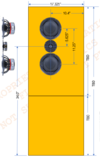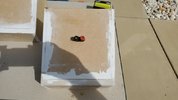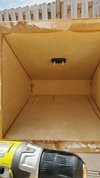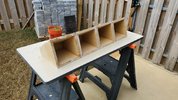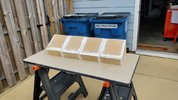I worked my 40 years and deserve every second of whatever life I have left!You retired fuckers have way too much time on your hands.
You are using an out of date browser. It may not display this or other websites correctly.
You should upgrade or use an alternative browser.
You should upgrade or use an alternative browser.
Heeman's New DIY MTM Project
- Thread starter heeman
- Start date
Sorry, missed this!The tee-pee is giving me Wilson Audio vibes! Can't wait to see these take shape!
Are you going to finish one complete speaker at a time or are you building both in parallel? Apologies if already stated.
The tee pee shape will eliminate a cabinet resonance vs a rectangular box. Flint can elaborate.
Building both at once.
I will mount drivers and get them going prior to finishing them (flat black paint).
Fasteners weaken MDF joints and not recommended, ever.Dumb question. Are these JUST glued together or are there fasteners somewhere that I don't see?
I've built thousands of enclosures from MDF using only glue and not a single one has ever failed at the joint. In fact, when I would test how they would fail, I managed to get dozens of unused enclosures (mostly prototypes and leftovers) to break and the break was the MDF near the joint broke, not the glue joint.
MDF is often the choice for loudspeaker enclosures because of the commonly available materials, it exhibits the best acoustic performance. It is self-dampened, the resonances are at higher frequencies due to the high mass per volume, and it is harder to excite into resonating than hard woods or most plywoods. Additionally, it is one of the cheapest materials you can get and it is extremely easy to work with.It seems to me that MDF is very common in building speakers, and I think I understand why. So, it comes down to the parts that actually move the air. How did you make the decision for choosing the midrange and tweeters that you chose? And I guess the woofers for that matter. Seems there would be a myriad of choices??
These cutting-edge midrange drivers are the latest and most advanced low distortion drivers with stunning dynamics for their size. You will not find a better midrange driver for true high-fidelity reproduction that this model without spending nearly double the price, and there are only a couple of drivers which compete with these regardless of the price.It seems to me that MDF is very common in building speakers, and I think I understand why. So, it comes down to the parts that actually move the air. How did you make the decision for choosing the midrange and tweeters that you chose? And I guess the woofers for that matter. Seems there would be a myriad of choices??
The tweeter is likewise one of the finest tweeters made. I am unaware of any tweeter model that is better other than the Scan-Speak Ellipticor soft dome tweeters which cost quite a bit more.
As for making choices, everything has to work together, and every choice impacts every other choice. Drivers need to work well together. The baffle has to work ideally for the tweeter's forward propagation and provide reasonable area for all the drivers, how the drivers fit on the baffle is extremely crucial, and that impacts the cabinets which provide acoustic loading for the midrange drivers. Addition to acoustic loading (Helmholtz resonance), the enclosure has to manage the acoustic waves inside it above the loading range to control standing waves and reflections, then you have to dampen the acoustics inside the enclosure to get the ideal balance between controlling reflections, reducing the Q, and not overdamping things and killing the low-end response. There are literally thousands of decisions one has to make when designing ultra-high-end loudspeakers. Nothing is interchangeable.It seems to me that MDF is very common in building speakers, and I think I understand why. So, it comes down to the parts that actually move the air. How did you make the decision for choosing the midrange and tweeters that you chose? And I guess the woofers for that matter. Seems there would be a myriad of choices??
These are NOT Wilson Audio knock-offs. Using odd-shaped enclosures to control internal reflections and standing waves goes back to the 50's and is common today in nearly all high-end loudspeakers, including the C1s these will be replacing. This design was intended to be easy enough for Heeman to make, so the truncated teepee design is a great solution versus trying to make a eggshaped enclosure.The tee-pee is giving me Wilson Audio vibes! Can't wait to see these take shape!
Are you going to finish one complete speaker at a time or are you building both in parallel? Apologies if already stated.
I have approximately 26 working hours into this so far.I am anxious at the breakneck pace Heeman is taking at completing these speakers.
I think I am past the halfway point, but that is just a guess.
mcad64
Well-Known Member
Flint,As for making choices, everything has to work together, and every choice impacts every other choice. Drivers need to work well together. The baffle has to work ideally for the tweeter's forward propagation and provide reasonable area for all the drivers, how the drivers fit on the baffle is extremely crucial, and that impacts the cabinets which provide acoustic loading for the midrange drivers. Addition to acoustic loading (Helmholtz resonance), the enclosure has to manage the acoustic waves inside it above the loading range to control standing waves and reflections, then you have to dampen the acoustics inside the enclosure to get the ideal balance between controlling reflections, reducing the Q, and not overdamping things and killing the low-end response. There are literally thousands of decisions one has to make when designing ultra-high-end loudspeakers. Nothing is interchangeable.
Sorry to harp on this but I am wondering specifically how/why you chose Purifi Midrange drivers and Morel TSCT Tweeters. Previous use? Specs alone? Ability to source? You've heard them in other speakers?
Seems there must be a myriad of tweeters and drivers out there, so why these two brands?
Thanks,
Mike
Coincidentally "Stumpy Nubs" just released a video today on working with MDF. I tend to agree more with Keith that properly-milled joints, plus lots of glue, is more secure for MDF than with adding fasteners, even if they get proper pilot holes; fasteners just seem to weaken the integrity of the sheet itself. ymmv.
EDIT: may help if I actually post the video, d'Oh!
EDIT: may help if I actually post the video, d'Oh!
Last edited:
That was Flint, not me.tend to agree more with Keith that properly-milled joints
BAH! I eat MDF sawdust as porridge and sprinkle it over my salads and pizzas. Real men wear it in their eyes and their nostrils as a badge of honor!The only downside to MDF is the dust. The dust is the worst. Obviously, this has nothing to do with material selection. MDF is clearly the best material. I just hate the dust.
Did I mention I hate MDF dust?

